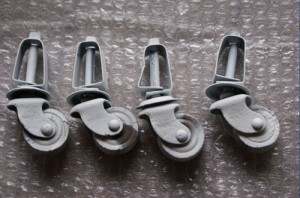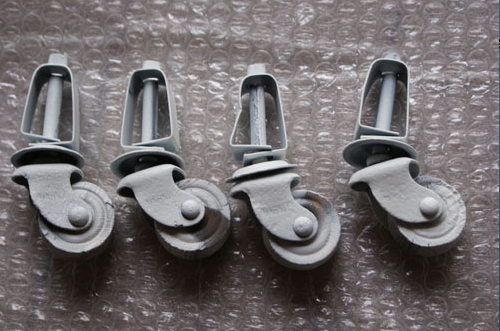Most antique iron bed casters, are worthless. Why you ask? Because they were made back in the 1800’s with no ball bearings. Iron beds are traditionally very solid and heavy, due to the poured cast iron castings and thick wall tubing that most all beds were being made with. The casters that were being made at the same time for these beds were adequate and efficient. But I doubt that the foundries and manufacturers considered the longevity and popularity their iron beds would have 150 to 200 years down the road.
There were two general types of casters being used back in the 1800’s. Both had metal sleeves that would collapse slightly to allow them to be inserted into the bottom of the tube. Once inserted these sleeves would then press back against the inside of the tube, holding it in place. The distinction between the two types of casters was one had a wooden wheel and the other was a metal wheel. They each had their advantages and disadvantages.
With regard to the beds that had wooden wheels….. over a period of time the metal shaft the wooden wheels were on didn’t allow for smooth rotation of the wheel itself. More often than not people, wanting to move their bed while it was still set up, tended to pull it….even if the wheel wasn’t turning properly and smoothly. Prolonged use in this fashion tended to wear the wooden wheel down in one area so it was no longer completely round and didn’t turn. So the bed was basically being pulled, not rolled into place. The good thing about wooden wheels, when they worked properly, was that they didn’t scratch wooden floors as did metal wheels.
Metal wheels tended to work better than their wooden counterpart. But they also had the disadvantage of rusting so they didn’t turn properly and also scratching hardwood floors.
Our practice, 100% of the time, is to remove any wheels we get in. They lend a false sense of security in being able to move a bed and also a degree of instability and movement to the head and foot  board. Which most people find very disconcerting.
board. Which most people find very disconcerting.
As time went on man realized neither wooden or metal casters had much of a prolonged life. Hence plastic. Also ball bearings presented a much smoother rotation with much less friction……. translating to longer life and better function.
So if you’re considering an antique iron bed for your bedroom. Please don’t think the old original wheels have any value or function………from a practical sense or a collectible antique value sense.
One last thing………..NEVER attempt to move your bed while it’s assembled with the mattress and box spring intact. When you do, you run the risk of pulling your bed “out of square”. When that happens you cause an undoes amount of stress on the “hitches” that connect the side rails to the head and foot board. When that happens you run the risk of cracking or snapping either the end of the side rail or the “hitch” itself. If this happens, you’re in deep trouble. These areas cannot be welded. Old cast iron has to be heated to almost the same temperature it was made at, to be able to be repaired. It takes a real modern day craftsman to make such a repair. Not your everyday welder.
So take care of your bed….enjoy it and treat it as you would anything else that was 150 to 200 years old……with respect.
I hope you’ve found this blog informative. I invite you to revisit my website
to answer any and all questions you might have about antique iron beds.
I also invite you to take a look at the multiple “Before & After” photo’s on our
company Facebook
at
http://www.facebook.com/pages/Cathouse-Antique-Iron-Beds/126838177398?ref=ts







